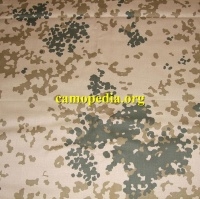Flecktarn Camouflage (GER)
The word "Flecktarn" comes from the German words "Fleck" (spot, dot, circle, spot...) and "Tarnung" (camouflage). This term was introduced by German designers in the 1970s during the Bundeswehr Truppenversuch 76 (or tests for the German army uniform in 1976). Several types and platforms were tested during the entire event. Subsequently, the type named "Flecktarnmuster" ("camouflage pattern with a spotted pattern") was finally selected as a general army inventory piece for the German army. Paradoxically, it was not approved "from above" until 1989. Some evidence also suggests that the original Flecktarn camouflage was designed by Marquardt and Schultz in cooperation with the French company Texunion.
The term "Flecktarn" is often misspelled as "Flectarn" or even "Flecktar" in some circles, which is why some people prefer to call all derivatives "dots." It is a fact, however, that the Flecktarn series camouflage pattern was adopted by a number of other countries besides Germany.
Some believe that camouflage patterns from the Flecktarn family may have been influenced in design by a camouflage pattern (Erbenmuster "pea camouflage" - from World War II). However, there is little evidence to confirm this. (Or more precisely - there is absolutely none.)
The original German camouflage pattern "Flecktarn" is five-colored and includes black, reddish-brown, dark olive, medium olive, and moss green. As for the desert version (initially called "Tropentarn," but later switched to the name "Wüstentarn"), it was initially introduced in 1993 and includes a bit of dark olive, reddish-brown, and yellow background.
What is the color distribution in the camouflage patterns "Flecktarn" and "desert Flecktarn"?
The color distribution for the standard Flecktarn is as follows: 13.3% is black, 41.2% is dark green, 17.5% is brown, 8.9% is light green, and 19.1% is gray-green.
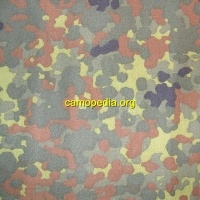
As for the color distribution in desert Flecktarn, it is the same as the classic one with the percentages, only it has a sand/beige shade instead of dark green, light green, and gray-green: i.e., The colors are as follows - 13.3% green, 69.2% sandy beige, and 17.5% brown.

What other international and national versions of the "Flecktarn" and "desert Flecktarn" camouflage patterns exist today?
In this matter, it is certainly worth mentioning Denmark, which was the first to test a variation on this design (incidentally it was camouflage pattern T/78) in 1978. And later, an adapted finalized version appeared (then it was camouflage pattern T/84) in 1984. The number of colors in the Danish version of the camouflage pattern was reduced from five to three. A distinctly desert variant was then introduced in the year 2000.
Belgium also at one time issued its own variation on the original Flecktarn camouflage pattern with very slightly modified colors and this was around 1990 and it was a revision here exclusively targeted for local Air Force Commandos (here for us, perhaps unexpectedly understood as units protecting airfields).
China also issued a total of two camouflage patterns which are an obvious clone of the legendary Flecktarn. The first was worn primarily as a summer training uniform. And another again by certain units intended for border activities. And as it turns out, it is a direct copy and not a variation, something in which China today is completely perfect. The second type is also five-colored, but here it has these colors: black, dark brown, bright reddish-brown, and olive green on a sand background. All this is mainly worn by PLA units in Tibet and within the Beijing military jurisdiction.
Poland also came with its bit on the clone scene. It issued a series of three Flecktarn-inspired camouflage and masking patterns. They were worn mainly by special units of the national police and the police security for internal affairs.
A detailed history of absolutely all "Flecktarn" and "desert Flecktarn" camouflage patterns
As we already know well, the period of increased interest in camouflage patterns emerged in the German army around the mid-1970s and led to the action "Bundeswehr Truppenversuch 76," or also: "Competition for the German uniform for 1976." This work subsequently led to the production and sometimes even acceptance of a number of camouflage patterns including the type "Sägezahnmuster" ("sawtooth camouflage pattern"), "Punktmuster" ("dotted camouflage pattern"), and three variations on the camouflage pattern called "Flecktarn." All three Flecktarn camouflage patterns were temporarily named by the army as "Flecktarn A" (klein)/("small"), "Flecktarn B" (groß)/("large"), and "Flecktarn C" (Schattenmuster)/("shadow pattern"). As we already know well, the camouflage pattern that was eventually chosen as the best was the type "Flecktarn B," although it took years before Bundeswehr decided to implement it.
It is indeed true that the adoption and implementation of a general camouflage pattern for the German army did not occur earlier than in the mid-1980s, when "Flecktarnmuster" was officially adopted by the German army as the standard camouflage. The German camouflage pattern "Flecktarn" since then has been seen as very effective, reflected in how it has influenced other designs, often deriving from it more or less. This has led to a number of clones in countries like Denmark, Japan, Poland, China, Belgium, etc. Germany itself also issued a desert version of the Flecktarn camouflage pattern and uses it (despite the broad and ever-growing international obsession with digital camouflage patterns lately).
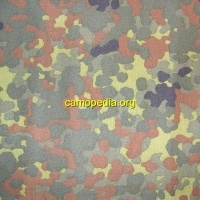
With Germany's increasing presence on various international missions (mostly so-called "Peace" missions) since the mid-1990s, this again ignited a desire for the renowned German perfectionism and the need to design and start using a Flecktarn series camouflage pattern intended primarily for tropical and warm areas. This led to and signed the necessary adoption of another Flecktarn series camouflage pattern and another version of "Fünf Farben Tarndruck der Bundeswehr" ("five-colored camouflage pattern for Bundeswehr"). This activity was also nicknamed "Tropentarn." These were camouflage patterns that were printed on lighter fabrics, which are more practical in very hot places (constant tropical or warm weather). This type of uniform was adopted in 2001. The camouflage pattern itself on this fabric was only a slight variation on already existing and so far very proven colors. In summary, it is just a minor modification of the standard "Flecktarnmuster."

Again following trends set by its NATO allies (most notably of course by the United Kingdom and France), in 1993 Germany began testing desert camouflage patterns based on the color scheme of its standard issued Flecktarn. Initially, the Germans called it "Tropentarn" (i.e., "Tropical camouflage"), although this was still an unofficial term. The early version contained sparsely placed dark olive and reddish-brown dots on a sand background. This desert-targeted camouflage pattern was in a testing phase for the years 1998-1999, until the first official desert version of this camouflage appeared. Officially, it was called "drei Farben Tarndruck der Bundeswehr" ("three-colored camouflage pattern for Bundeswehr"), but the pattern is referred to mostly and usually as "Wüstentarndruck" (or also "desert camouflage pattern") or "Desert Flecktarn pattern" (that again in English speaking parts of the world).
Even though numerous rumors surfaced over the years about there being two versions of the desert camouflage pattern at that time, sources directly from Germany indicate that technically it isn't true. Although early testing versions (approximately from years 1993-1999) may have had slightly different coloring, the official version from 1999 is completely standardized. Often it happens that when washing this camouflage pattern with other types of laundry, it slightly changes colors. Either way, the three-colored desert type is standard equipment for all German military forces preparing consistently for deserts/dry hot places. From the design, it is also clear that slight vegetation is assumed here, not just sand.
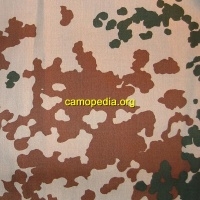

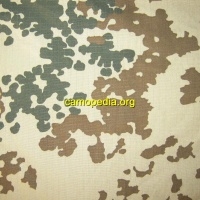
It is also a fact that certain elements of the German army have already adopted (just like other similar units around the world), particularly we are speaking here especially about the "Kommando Spezialkräfte" (KSK), for their own part something from the Multicam series.
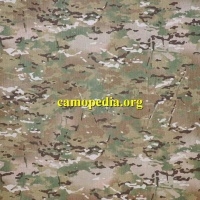
Very unexpectedly, at the end of 2015, it was announced that the Bundeswehr would introduce two brand new camouflage patterns based on the "flecktarn" series. What was missing was complemented again: i.e., A camouflage pattern meant for snowy/icy and arctic conditions and was to be a universal camouflage intended for people from the German army who went somewhere on a mission or were stationed outside Germany. Initial research on this topic began around 2012, with oversight from people from "Wehrwissenschaftliche Institut für Werk- und Betriebsstoffe der Bundeswehr (WIWeB)" (this could be translated as: "Federal Army Material and Supply Research Institute"). The new type is called "Multitarn," as it was apparent that it would be a multi-purpose camouflage pattern.
This new type then bears the colors in this combination: light green, dark green, brown, beige, gray, and dirty white. It is a design based on everything about the standard "standard BW flecktarn" pattern. It will initially be available only to the section of the German army responsible for all-form special operations (KSK). Hopefully, over time, it will also spread among ordinary ranks, as it is a type offering a very attractive feature: Multitarn is more effective compared to other types of this series in confusing night vision images.
Where else have "Flecktarn" and "desert Flecktarn" camouflage patterns appeared?
Another camouflage pattern tested within "Truppenversuch 76" was one called "Punktmuster" or "dotted camouflage pattern." In some aspects, it is quite similar to the Flecktarn family, but it has dots that are much smaller and also much denser compared to them.
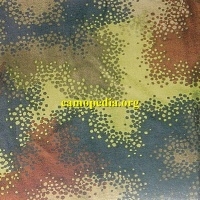
And here we have an experimental variation on "Desert Flecktarn," but this one has a slightly different color palette compared to the standard one. However, it seems to relate only to commercial markets and not the army.
